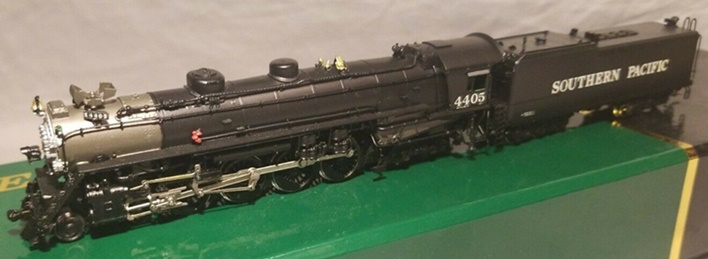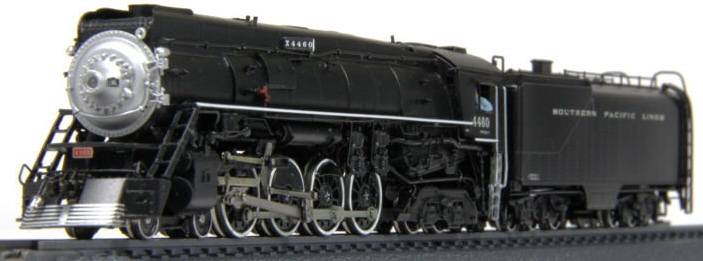

Introduced: 2005
These brass locomotives were designed in Japan by More Co and manufactured in Korea by LIK Enterprise Inc. Original MSRP's ranged from $1100 to $1300. And since they hardly ever show up on eBay, I'm assuming the production numbers were fairly limited. Several different versions were produced -
- SP GS-1
- SP GS-2 (Daylight, Skirted and De-Skirted)
- SP GS-6 (pictured above)
- WP GS-64
- T&NO GS-1
The chassis is all metal, although it's also fairly minimalistic (with the shell providing most of the actual heft) -

The motor is a coreless Faulhaber (#13191012S). The worm gearbox and motor bracket are firmly mounted to the frame (IE not sprung). The driveshaft consists of a trio of plastic U-joints. Right-rail pickup is provided by the four right-side drivers (there are no traction tires). Left-rail pickup is provided by the six left-side tender wheels. All the rest of the wheels are electrically neutral. Current is transferred from the tender to the locomotive by way of a stiff wire on the drawbar. Only the #3 drivers are geared (with the remaining drivers being turned solely by the cranks). The drivers mount to the frame inside of bearing blocks that seat inside cutouts in the frame. All of the drivers have coiled suspension springs.

The pilot coupler is a dummy (IE, non-operational) knuckle, whereas the tender coupler is a chassis-mounted Micro-Trains. The shell includes cab interior detailing. The wheels are low-profile, so no problems on Code-55 track. The pilot truck and tender trucks are all sprung. Like many eight driver steamers, this locomotive will instantly derail on 11"-radius (or sharper) curves. Realistically speaking, I'd say that 15-16" is going to be your minimum operating radius for one of these. The drawbar has two holes - one for extreme close-coupling. The tender chassis has holes in it for those interested in installing a sound decoder.
These models have working headlights and backup lights. And owing to a complex series of diodes and whatnot, said lighting is bright, constant and directional. Plug/socket connectors for the headlight wiring makes it possible to completely separate the locomotive shell from the chassis.
Performance is simply outstanding (comparing quite favorably with Kato's mass-manufactured SP Northerns). At first I was a bit concerned about the old-school pickup and drawbar-wiring scheme, but my worries turned out to be unfounded as I didn't experience any pickup-related issues at all (IE no stalling, no stuttering, etc). Overall throttle response is nimble, slow speed creep is excellent, the top-end speed is very reasonable, and I had no problems with any of the wheels derailing (excepting, as noted above, on very sharp curves). The model runs smoothly and quietly at all throttle levels (no shaking, shimmying, wobbling, binding, grinding, buzzing or any of that other bad steam nonsense). And despite the lack of traction tires, pulling power is quite strong. I don't know what the actual upper limit might be, but mine can easily haul 30+ assorted freight cars through curves on level track. I guess my only minor gripe is with the sprung tender trucks, as they do tend to make the tender somewhat wobbly and unstable as it rolls along. But that minor quibble aside, these are terrific models that run every bit as good as they look.
GS-1 -

GS-2 Daylight -

GS-6 -

To remove the locomotive shell, first remove the two small screws on the back/bottom of the cab. Next, remove the screw that holds the pilot truck in place. The socket for that screw is in itself a screw - so, remove that and the shell should lift off readily. To remove the tender shell, remove the three small screws on the bottom of the chassis.
Grade: A